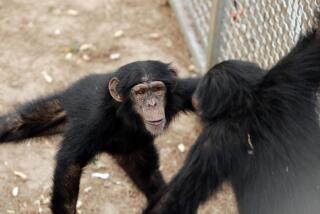Getting the point: African elephants understand human gestures
- Share via
African elephants really get the point -- the finger point that is.
At least that’s the conclusion of a study published Thursday in the journal Current Biology that examined the behavior of 11 pachyderms who were pointed in the direction of hidden snacks.
According to study author Richard Byrne, a professor of evolutionary psychology at the University of St. Andrews in Scotland, African elephants will investigate the contents of a container 68% of the time if a human points to it.
By comparison, a 12-month-old human will check out the indicated container 73% of the time.
Study authors experimented with a group of African elephants at a wildlife research and rehabilitation center in Zimbabwe. The test subjects, who had names like Coco, Jake and Malasha, were placed in front of two buckets, one of which contained a snack.
A human experimenter would stand between the buckets and point to the one that had the treat. (The elephants could not see into the buckets, and controls were conducted to ensure that the animals weren’t simply sniffing out the treats.)
“Our results show that elephants spontaneously attend to and correctly interpret human ... gestures without extensive prior learning opportunities -- the only nonhuman species so far to show this ability,” wrote Byrne and his graduate student coauthor, Anna Smet.
Though domesticated cats, goats, horses and dogs especially can pick up on human cues such as pointing, it remains a topic of great debate on just why this happens.
While some argue that these traits evolved because of close interaction with humans over the centuries, others suggest it may be an innate ability of group-living animals.
Those who support the latter case argue that the ability to pick up on the directions or cues of others would be helpful to animals who either hunt or try to avoid predators as a pack or herd.
The Current Biology study appears to support that view.
“We suggest that the most plausible account of our elephant’s ability to interpret even subtle human pointing gestures as communicative is that human pointing ... taps into elephants’ natural communication system,” the authors wrote.
“If so, then interpreting movements of other elephants as ... communication must be a natural part of social interaction in wild herds; specifically, we suggest that the functional equivalent of pointing might take the form of referential indication with the trunk.”
However, there are other social animals that appear not to get the point.
“Surprisingly, Asian elephants have been found not to respond to human-given gestural cues,” authors wrote.
ALSO:
Cirrus-ly? MIT scientists make icy Martian clouds on Earth
What exactly is a Higgs boson? An explanation for the rest of us
U.S. Antarctic research victim of shutdown; losses are irreplaceable






